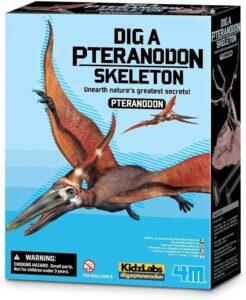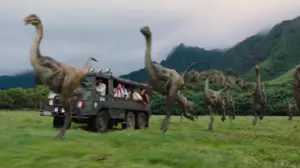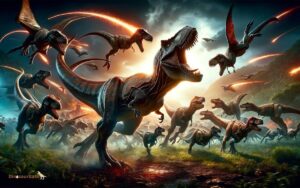Where Dinosaurs on the Ark
Just as a ship embarks on a journey through uncharted waters, the question of whether dinosaurs were on the Ark navigates through a sea of historical, scientific, and theological debates.
The Biblical Ark narrative, juxtaposed with the timeline of dinosaur extinction, presents a puzzle that has both intrigued and divided experts and enthusiasts alike. They're faced with the challenge of reconciling religious texts with paleontological evidence, a task that's not for the faint-hearted.
This exploration invites curious minds to consider the myriad interpretations and theories that have emerged, leaving one to ponder the boundaries where faith and science meet.
Key Takeaways
- Fossil evidence shows dinosaurs went extinct 65 million years before humans existed.
- Scientific consensus does not support the coexistence of humans and dinosaurs.
- The size and needs of dinosaurs present significant logistical challenges for Ark accommodation.
- Integrating dinosaurs into Ark narratives conflicts with established scientific understanding and evidence.
The Biblical Ark Narrative
The Biblical Ark narrative, rooted in the Book of Genesis, describes Noah's construction of a large vessel at God's command to save his family and representatives of all the world's animals from a global flood. This account has been analyzed extensively within theological and historical contexts. Scholars often scrutinize its feasibility, focusing on the ark's dimensions, the logistics of gathering species, and the ecological aftermath.
The narrative specifies that Noah took onto the ark pairs of every kind of animal, bird, and creeping thing to preserve their species. Scientific inquiry into this narrative evaluates the biological diversity possible within the ark's constraints, considering factors like space, food, and care requirements. This analysis provides a basis for understanding the story's implications within a broader historical and ecological framework.
Dinosaurs: An Overview
Dinosaurs, a diverse group of reptiles, dominated Earth's terrestrial ecosystems for over 160 million years before their abrupt extinction approximately 65 million years ago.
Research categorizes them into various types, each with unique adaptations and ecological roles, as evidenced by fossil records.
Theories on their extinction range from catastrophic events to gradual environmental changes, with ongoing discoveries continually refining our understanding of their timeline and existence.
Dinosaur Types Explained
Understanding the diverse types of dinosaurs that once roamed the Earth requires delving into the rich tapestry of prehistoric life, cataloged through extensive paleontological research. Dinosaurs, belonging to the clade Dinosauria, diverged into two main groups: the Saurischia, or 'lizard-hipped' dinosaurs, which includes the theropods (like Tyrannosaurus rex) and sauropodomorphs (like Brachiosaurus); and the Ornithischia, or 'bird-hipped' dinosaurs, which encompassed species such as Triceratops and Stegosaurus.
This classification is grounded in anatomical differences in their pelvic structures. Further distinctions are drawn based on dietary preferences, with some dinosaurs being herbivorous, others carnivorous, and a few omnivorous. The evolutionary adaptations observed in these creatures—ranging from the long necks of sauropods to the sharp teeth of theropods—highlight the diverse ecological niches they occupied.
Extinction Theories
Exploring the diverse types of dinosaurs reveals the complexity of their existence, yet it's their sudden disappearance from Earth's history that captures the scientific community's attention, focusing on various extinction theories. Researchers have proposed several hypotheses to explain this mass extinction event:
- Asteroid Impact Theory: Suggests a colossal asteroid collision with Earth, causing drastic climate changes.
- Volcanic Activity: Extensive volcanic eruptions could have altered the atmosphere, leading to a significant cooling period.
- Climate Change: Gradual changes in Earth's climate might've made the planet inhospitable for dinosaurs.
- Disease: Epidemics could have spread among dinosaur populations, leading to their decline.
- Competition from Other Species: Rising new species might've outcompeted dinosaurs for resources.
Each theory offers insights, yet it's likely a combination of factors contributed to the dinosaurs' extinction.
Fossil Discovery Timeline
The timeline of dinosaur fossil discovery begins in the early 19th century, marking a pivotal era in paleontology that has significantly expanded our understanding of prehistoric life. Prior to this period, dinosaur remains were often misidentified or misunderstood. It wasn't until 1824 that William Buckland scientifically described the first dinosaur, Megalosaurus, setting the stage for future discoveries.
This watershed moment underscored the importance of systematic study and classification in paleontology. Subsequent finds, including the Iguanodon by Gideon Mantell in 1825 and the extensive work of Richard Owen, who coined the term 'Dinosauria' in 1842, further cemented dinosaurs' place in the scientific community.
These milestones, rooted in rigorous analysis and evidence, have paved the way for modern paleontological methods, allowing scientists to piece together the complex tapestry of Earth's ancient past.
Historical Interpretations
Historical interpretations reveal that the question of whether dinosaurs were on the ark has sparked considerable debate among scholars and researchers. The discourse delves deep into ancient texts, fossil records, and cultural narratives, striving to bridge the gap between religious beliefs and scientific evidence.
- Ancient texts seldom mention creatures resembling modern understanding of dinosaurs, questioning their presence during the ark's era.
- Interpretations of religious scriptures vary, with some suggesting metaphorical representations rather than literal historical accounts.
- The fossil record provides no direct evidence linking dinosaurs to the time period of the ark's journey.
- Cultural narratives from various civilizations offer differing accounts of creatures that might be interpreted as dinosaurs.
- Scholars emphasize the importance of contextualizing historical documents and archaeological findings to avoid anachronistic interpretations.
This approach ensures a balanced understanding, respecting both scientific inquiry and historical context.
Scientific Timeline Challenges
The scientific timeline challenges the notion of dinosaurs coexisting with humans and being present on the Ark, primarily through dinosaur extinction dates, ark construction timeline, and fossil record evidence. These points suggest a significant temporal discrepancy, as dinosaurs are believed to have become extinct approximately 65 million years before the estimated time of the Ark's construction.
A rigorous examination of fossil records further undermines the possibility, indicating a clear separation in the geological timeline between the existence of dinosaurs and humans.
Dinosaur Extinction Dates
Despite popular misconceptions, scientific evidence strongly indicates that dinosaurs became extinct approximately 65 million years ago, presenting significant challenges to literal interpretations of ancient timelines. This understanding comes from multiple lines of evidence:
- Fossil Records: Show a distinct absence of dinosaur fossils above the Cretaceous-Paleogene boundary.
- Radiometric Dating: Provides accurate age estimates for rock layers, confirming the timeline.
- Mass Extinction Events: Evidence suggests a catastrophic event, such as an asteroid impact, led to their extinction.
- Geological Evidence: Supports the sudden disappearance of dinosaurs, aligning with the impact hypothesis.
- Evolutionary Biology: Illustrates the emergence of new species post-dinosaur era, indicating a significant evolutionary shift.
This body of evidence collectively challenges notions that dinosaurs could have coexisted with humans or survived into more recent historical periods.
Ark Construction Timeline
Examining the timeline of Ark construction presents significant challenges when juxtaposed against the scientific understanding of Earth's history. According to biblical narratives, the Ark was built roughly 4,000 years ago. However, scientific evidence suggests that this timeline is problematic when considering the age of the Earth and the extinction of dinosaurs.
Radiometric dating, a reliable scientific method, estimates the Earth to be about 4.5 billion years old. Furthermore, it places the extinction of dinosaurs approximately 65 million years ago, far preceding any possible construction of the Ark. This discrepancy raises critical questions about the feasibility of dinosaurs coexisting with humans in a manner that would allow their inclusion on the Ark, given the vast differences in timelines supported by scientific research and biblical accounts.
Fossil Record Evidence
Analyzing the fossil record presents a stark challenge to the notion of dinosaurs coexisting with humans or being present on the Ark, as it clearly delineates a timeline where these ancient reptiles became extinct millions of years before humans appeared. This evidence-based analysis reveals:
- Radiometric dating of dinosaur fossils places their extinction approximately 65 million years ago.
- The earliest human ancestors emerged much later, around 6 million years ago.
- Stratigraphic layers consistently show dinosaur remains far below those of human or contemporary animal species.
- No credible scientific evidence supports the coexistence of humans and dinosaurs.
- The fossil record indicates a clear chronological sequence of life on Earth, contradicting any claims of their simultaneous existence or survival through a global flood scenario.
This data underscores the impossibility of dinosaurs being aboard any Ark in a historical or scientific context.
Theological Perspectives
Theological perspectives offer diverse interpretations of whether dinosaurs were present on Noah's Ark, grounded in scriptural analysis and historical context.
Some scholars suggest that the comprehensive term 'all flesh' used in Genesis could encompass dinosaurs, arguing that early interpretations of biblical texts didn't exclude any species from Noah's cargo. They propose that dinosaurs, as part of God's creation, would merit preservation from the flood.
Conversely, others argue that the absence of specific mention of dinosaurs, combined with their likely physical requirements, suggests they weren't aboard. This debate hinges on interpretations of biblical language and the integration of historical timelines, with each viewpoint seeking to reconcile scientific evidence with scriptural narratives.
Ultimately, these theological discussions highlight the complexities of integrating ancient texts with modern scientific understandings.
Ark Size and Logistics
The analysis of the Ark's dimensions reveals critical insights into its capacity to house various species, including the feasibility of accommodating dinosaurs.
Strategies for species accommodation must consider the spatial requirements and the biological needs of each species, ensuring their survival over the Ark's voyage.
Efficient provisions and space management are paramount in addressing the logistical challenges posed by such a diverse group of inhabitants.
Ark Dimensions Analysis
In assessing the logistics and dimensions of the Ark, it's crucial to consider the reported measurements and how they'd accommodate the vast array of species purported to be on board.
- The Ark's dimensions, as reported, suggest a significant capacity, yet raise questions regarding the spatial allocation for each species.
- Efficient design would be essential to maximize useable space, factoring in needs for movement, feeding, and separation of species.
- The structural integrity required to support the weight of numerous species simultaneously poses a considerable engineering challenge.
- Ventilation and waste management systems would need to be extraordinarily advanced to sustain life over extended periods.
- The logistical planning for food and water supplies would require meticulous calculation to prevent shortages.
These considerations underscore the complexity of housing a diverse collection of species within the reported dimensions of the Ark.
Species Accommodation Strategy
Developing a species accommodation strategy for the Ark necessitated innovative solutions to maximize limited space while ensuring the survival and well-being of a diverse array of species. Scientists proposed using a tiered system, categorizing animals by size, dietary needs, and habitat requirements.
This approach allowed for the efficient use of space by allocating areas within the Ark tailored to the specific needs of different species groups. For instance, smaller animals could be housed in compact, stackable enclosures, optimizing vertical space. Meanwhile, larger animals required more strategically designed areas to accommodate their size and movement.
The planning also involved considerations for the microclimates needed by various species, ensuring temperature and humidity levels were adequately maintained. This evidence-based strategy aimed to facilitate the cohabitation of numerous species in a confined environment.
Provisions and Space Management
Managing provisions and optimizing space within the Ark required meticulous planning and a comprehensive understanding of logistical constraints. Given the Ark's finite dimensions, strategizing the allocation of space for both dinosaurs and provisions was paramount. The analysis of these logistical challenges reveals the following key points:
- Efficient space utilization was crucial for accommodating diverse species.
- Innovative storage solutions were necessary for maximizing provision capacity.
- Detailed inventory management helped in tracking consumption rates and replenishing supplies.
- The design and layout of the Ark had to support the physical needs of all onboard.
- Strategic compartmentalization allowed for the segregation of species to prevent conflict and ensure safety.
This approach underscores the complexity of managing such a unique ecosystem, highlighting the need for precision in planning and execution.
Myth Vs. Reality
The notion that dinosaurs were on Noah's Ark is a myth unsupported by scientific evidence or historical records. Scientifically, dinosaurs became extinct approximately 65 million years ago, a timeline that precedes humans and the construction of Noah's Ark by millions of years.
Analyzing sedimentary layers and fossil records, paleontologists have established a clear chronology of Earth's history that contradicts the possibility of dinosaurs coexisting with humans. Furthermore, the logistical challenges of housing such massive creatures, alongside the diversity of species described in ancient texts, underscore the implausibility of this myth.
It's crucial for readers seeking understanding to differentiate between mythological interpretations and scientific facts. The evidence-based approach firmly places the presence of dinosaurs on the Ark within the realm of myth, not reality.
Extinction Theories
Several theories have emerged to explain the extinction of dinosaurs, ranging from catastrophic events to gradual environmental changes. Scientists have meticulously analyzed geological and fossil records to form hypotheses that could elucidate this mass extinction event. The prevailing theories suggest a complex interplay of factors rather than a single cause.
- Asteroid Impact: A colossal asteroid hitting Earth, creating a dust cloud that blocked sunlight.
- Volcanic Activity: Massive volcanic eruptions releasing sulfur dioxide and carbon dioxide, altering the climate.
- Climate Change: Significant shifts in climate leading to unsuitable living conditions.
- Sea Level Changes: Fluctuations in sea levels disrupting ecosystems.
- Competition from Mammals: Rising mammalian species outcompeting dinosaurs for resources.
These theories highlight the multifaceted nature of dinosaur extinction, emphasizing the impact of both sudden catastrophic events and gradual environmental shifts.
Contemporary Debates
Current debates in the scientific community focus on refining our understanding of the factors that contributed to the dinosaurs' extinction, with new evidence continually reshaping these discussions.
Researchers scrutinize the interplay between massive volcanic eruptions, climate change, and asteroid impacts to delineate their respective roles in this prehistoric event. Advances in radiometric dating techniques and sedimentary analysis provide a more precise timeline of these occurrences, challenging previous assumptions.
Moreover, the discovery of iridium-rich layers in geological strata worldwide supports the asteroid impact hypothesis, yet doesn't dismiss the significance of volcanic activity and climate shifts. Scientists now explore the nuanced effects of these factors on different dinosaur species, aiming to construct a comprehensive model of their extinction.
This ongoing dialogue underscores the complexity of Earth's history and the intricate processes that govern species survival and extinction.
Cultural Impact
Throughout history, dinosaurs have captivated the cultural imagination, influencing various aspects of art, literature, and science with their monumental legacy. Their impact is vast and varied, extending beyond mere fascination to significantly shaping our understanding of Earth's history and biological diversity.
- *Dinosaurs in cinema and literature* have popularized paleontology, sparking public interest and scientific inquiry.
- *Educational content and museums* leverage dinosaurs to engage and educate about evolutionary biology and geology.
- *Artistic representations* reflect changing scientific perceptions and fuel cultural discourse on nature and extinction.
- *Themed entertainment and merchandise* demonstrate the commercialization of dinosaurs, influencing consumer culture.
- *Philosophical and ethical discussions* inspired by dinosaurs explore themes of existence, survival, and human impact on the environment.
Each point underscores the profound influence dinosaurs exert on the cultural fabric, enriching both scientific understanding and imaginative exploration.
Future of Research
As we peer into the horizon of paleontological research, emerging technologies and methodologies are set to revolutionize our understanding of dinosaurs and their world.
Advances in imaging techniques, such as high-resolution micro-CT scans, allow scientists to explore the internal structures of fossilized remains without damaging them. This non-invasive method provides unprecedented insights into the anatomy and development of dinosaurs.
Additionally, the integration of computer simulations and 3D modeling offers a dynamic approach to reconstructing the behavior and movement of these ancient creatures.
Paleogenomics, the study of ancient DNA, holds the potential to unlock the genetic secrets of dinosaurs, shedding light on their evolutionary relationships with modern species.
Together, these advancements promise to deepen our comprehension of dinosaur biology, ecology, and their place in Earth's history.
Conclusion
In conclusion, the notion of dinosaurs aboard Noah's Ark treads a fine line between myth and reality, challenging both scientific and theological realms. Despite compelling evidence placing dinosaur extinction millions of years prior to human existence, the debate lives on.
This enduring controversy not only highlights our quest for understanding but also underscores the complex interplay between faith and facts. As research progresses, one can only hope for a harmonious reconciliation of these seemingly disparate narratives, illuminating our past with newfound clarity.





